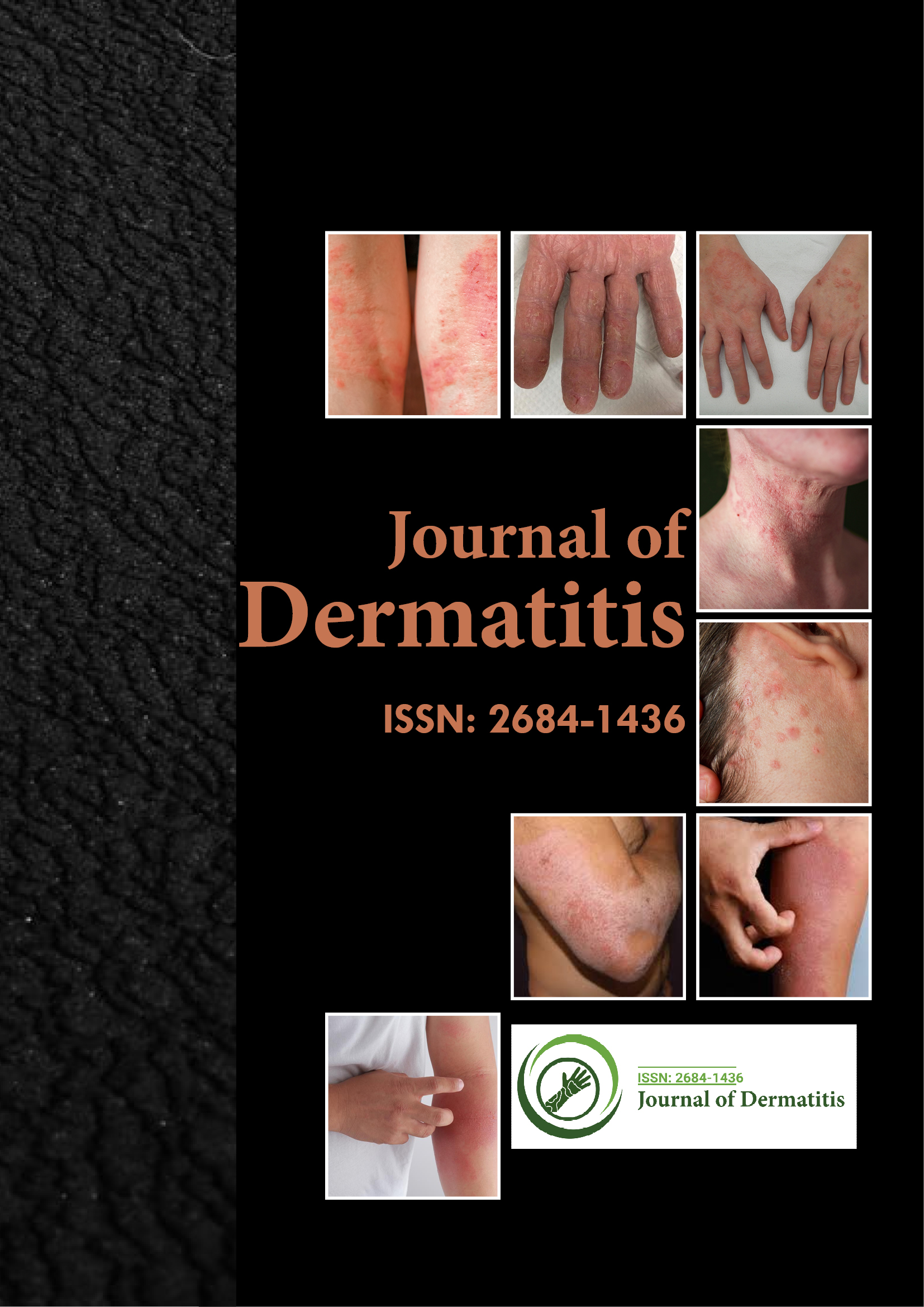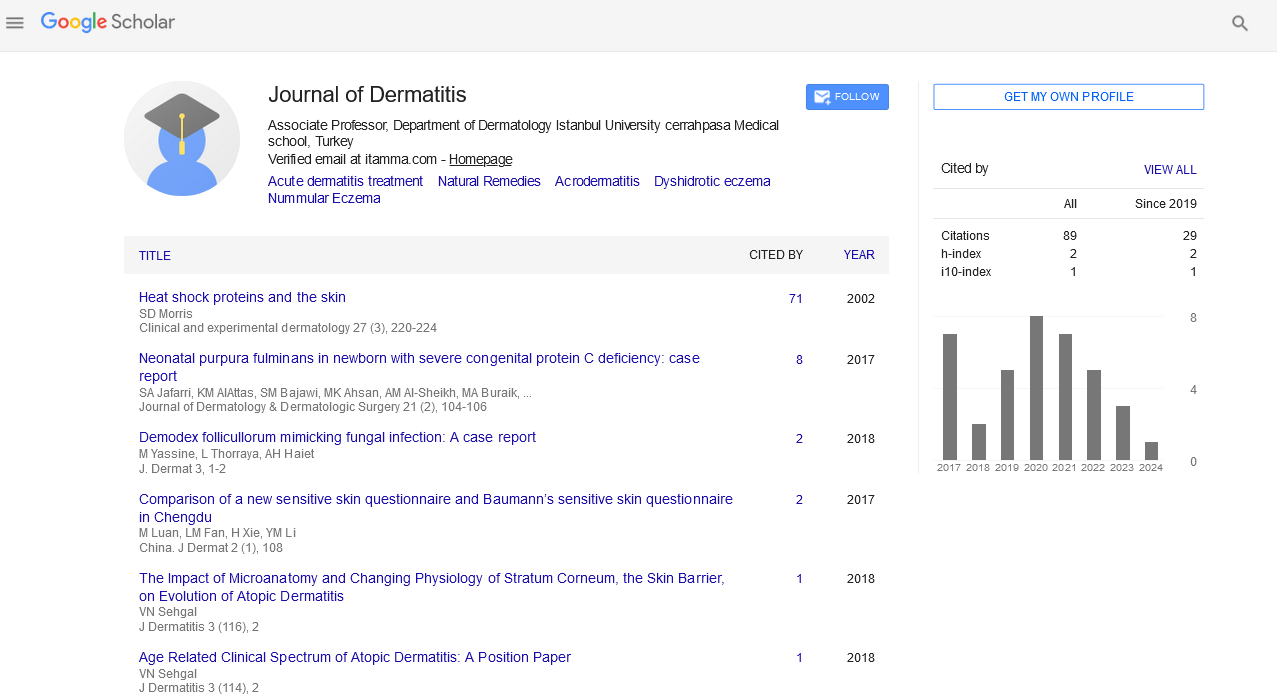Indexed In
- RefSeek
- Hamdard University
- EBSCO A-Z
- Euro Pub
- Google Scholar
Useful Links
Share This Page
Journal Flyer

Open Access Journals
- Agri and Aquaculture
- Biochemistry
- Bioinformatics & Systems Biology
- Business & Management
- Chemistry
- Clinical Sciences
- Engineering
- Food & Nutrition
- General Science
- Genetics & Molecular Biology
- Immunology & Microbiology
- Medical Sciences
- Neuroscience & Psychology
- Nursing & Health Care
- Pharmaceutical Sciences
Commentary - (2025) Volume 10, Issue 2
Long-term Safety of Topical Corticosteroids in Dermatitis Treatment: An Overview
Anne Christine*Received: 19-Jan-2024, Manuscript No. JOD-24-24657; Editor assigned: 23-Jan-2024, Pre QC No. JOD-24-24657 (PQ); Reviewed: 06-Feb-2024, QC No. JOD-24-24657; Revised: 06-Jan-2025, Manuscript No. JOD-24-24657 (R); Published: 13-Jan-2025, DOI: 10.35248/2684-1436.25.10.276
Description
Topical Corticosteroids (TCS) have been a first line in the treatment of various dermatologic conditions, including dermatitis, for decades. These medications, which exert antiinflammatory and immunosuppressive effects, are commonly prescribed to alleviate symptoms such as itching, redness, and inflammation associated with dermatitis. While TCS are highly effective, concerns have been raised about their long-term safety, prompting a thorough exploration of their risks and benefits in the context of prolonged use.
Dermatitis, a general term referring to inflammation of the skin, encompasses a range of conditions, each with its own etiology and clinical presentation. Atopic dermatitis, contact dermatitis, and seborrheic dermatitis are among the common dermatologic disorders that often necessitate the use of TCS for symptom management. These agents, available in various formulations such as creams, ointments, and lotions, are classified based on their potency, with higher potency corticosteroids reserved for more severe cases.
The efficacy of TCS in providing rapid relief from dermatitis symptoms is well-established. These medications function by modulating immune responses, suppressing inflammation, and inhibiting the release of pro-inflammatory cytokines. However, concerns about the potential adverse effects associated with longterm TCS use have led to ongoing discussions and investigations in the medical community.
One of the primary concerns associated with prolonged TCS use is the potential for skin atrophy. Skin atrophy refers to the thinning of the skin layers, leading to reduced elasticity and integrity. While skin atrophy is a well-documented side effect of TCS, its occurrence is often related to factors such as the potency of the corticosteroid, the duration of use, and the specific site of application.
High-potency TCS, especially when applied to thin or sensitive skin areas such as the face, neck, or genital region, pose a higher risk of inducing skin atrophy. This risk determine the importance of tailoring TCS treatment plans based on the severity and location of dermatitis. Low-potency corticosteroids are typically recommended for more delicate skin areas, minimizing the likelihood of atrophic changes.
To mitigate the risk of skin atrophy, dermatologists often advocate for the appropriate and judicious use of TCS. This includes using the lowest potency corticosteroid that effectively manages symptoms, employing intermittent rather than continuous treatment, and incorporating non-corticosteroid alternatives when appropriate. The goal is to strike a balance between achieving therapeutic efficacy and minimizing the potential for adverse effects.
The risk of systemic absorption of TCS and its potential consequences are also considerations in the evaluation of longterm safety. While topical application of TCS is intended to exert its effects locally on the skin, a certain degree of systemic absorption can occur. Systemic absorption may be influenced by factors such as the potency of the corticosteroid, the surface area of application, and the use of occlusive dressings.
In children, whose skin is generally more permeable, the risk of systemic absorption is a particular concern. Pediatric patients may be more susceptible to the adverse effects of TCS, including the potential impact on growth and the Hypothalamic-Pituitary- Adrenal (HPA) axis. Monitoring the use of TCS in pediatric populations and adopting the lowest effective potency are essential strategies to minimize risks.
The risk of developing tachyphylaxis, a phenomenon where the efficacy of TCS diminishes with prolonged use, is another consideration in the context of long-term treatment. While the exact mechanisms underlying tachyphylaxis are not fully understood, it is believed to be related to desensitization of the skin's responsiveness to corticosteroids. This phenomenon emphasizes the importance of carefully managing the duration and frequency of TCS use to maintain therapeutic efficacy.
Patient education is a fundamental of ensuring the safe and effective use of TCS in the long term. Dermatologists plays an important role in communicating the importance of adherence to prescribed regimens, the potential risks associated with overuse, and the need for regular follow-up appointments. Open communication between healthcare providers and patients fosters a collaborative approach to dermatitis management, empowering individuals to make informed decisions about their treatment.
Conclusion
The long-term safety of topical corticosteroids in the treatment of dermatitis remains a subject of careful consideration and ongoing research. While these medications offer effective relief from the symptoms of dermatitis, concerns about potential adverse effects, such as skin atrophy, telangiectasia, systemic absorption, and tachyphylaxis, determine the need for a cautious and individualized approach to their use. The judicious selection of the appropriate potency, duration, and formulation of TCS, along with regular monitoring and patient education, are essential components of optimizing the safety profile of these widely used dermatologic agents. As research continues to advance, the field holds the potential of developing even safer and more targeted therapeutic options for the long-term management of dermatitis.Citation: Christine A (2025) Long-Term Safety of Topical Corticosteroids in Dermatitis Treatment: An Overview. J Dermatitis. 10:268.
Copyright: © 2025 Christine A. This is an open access article distributed under the terms of the Creative Commons Attribution License, which permits unrestricted use, distribution, and reproduction in any medium, provided the original author and source are credited.

